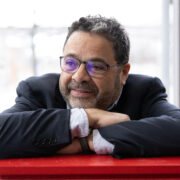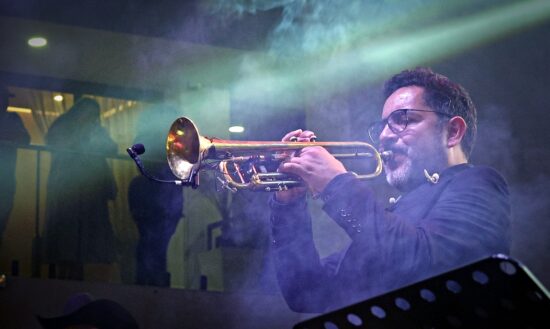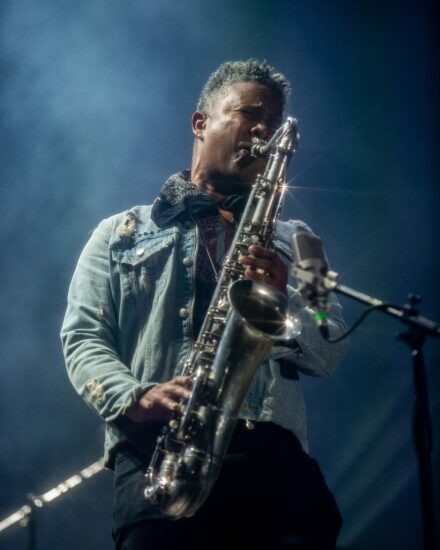After the last international San Diego Tijuana Jazz Festival ceased operations in the late ’80s, Daniel Atkinson — the educator, producer and jazz polymath — seriously considered bringing another multiday jazz event to the region. But what should it look like, and what’s the best way to attract attendees?
The San Diego native had become increasingly involved with Mexico through past projects in Tijuana and Ensenada. “I got to thinking,” he recalled, “that what we should do here is something almost no other place in America can do. To have a festival that takes place on both sides of an international border in sizable cities. San Diego is the eighth largest in the U.S., and Tijuana is the third largest in Mexico, with a total population of about seven million.”
Another festival inspiration was the memory of organizing with his now deceased former partner, Ivan Irving; a 2018 tour that brought the legacy band Mingus Dynasty to play the Tijuana Moods album in five cities including San Diego and Tijuana. It concluded at Mingus Memorial Park in Nogales, Arizona, where the late bandleader was born. Also occurring the same year, Arturo O’Farrill and his Afro Latin Jazz Orchestra made a live recording and performance at the border wall itself.

San Diego and Tijuana’s musical and jazz history, often little known or forgotten, is plentiful. Atkinson strives to make it a central theme of SDTJF. He commented, “That’s very important to me and part of the aim of the festival is to allow people to discover and celebrate that. The Jelly Roll Morton piece (for the inaugural 2024 concert) was just a fantastic thing that was virtually unknown. He wrote some of his most important compositions in Tijuana during Prohibition, and we incorporated commissioned numbers by Gerald Clayton and the electronica Nortec Collective.”
The connection between Tijuana and Americans, Black Americans in particular, has fostered the creation of some extraordinary music: Mingus’s Tijuana Moods, Arthur Blythe’s Down San Diego Way, Arturo O’Farrill’s Fandango at the Wall, Antonio Sanchez’s Lines in the Sand. Atkinson pointed out, “This is a rich vein that we will continue to mine as we move forward, including more commissions from contemporary artists.”
This year’s SDTJF will not include commissioned works, but it will host “James Moody @ 100,” which aligns with the celebration in New York and was suggested by Moody’s widow, Linda.
The special segment coalesces the incredible talents of saxophonist David Sánchez, bassist John Clayton, pianist Gerald Clayton, drummer Lewis Nash, flutist Holly Hofmann and trumpeter Gilbert Castellanos. “People don’t realize that Moody lived here for 20 years and wasn’t just passing through,” Atkinson remarks. Other longtime jazz musicians who resided in San Diego include Barney Kessel, Mundell Lowe and George Nicolaidis.

Atkinson also highlighted some of the notable selections written in or about San Diego and Tijuana. Trumpeter Iván Trujillo — one of the leading jazz musicians, educators and jazz promoters in Baja California and a 2024 recipient of the Jazz Journalists Association’s Jazz Hero Award (the first in Mexico) — will play Bennie Maupin’s “Ensenada” from his 1974 ECM record Jewel in the Lotus. Arturo O’Farrill and the Afro Latin Jazz Orchestra will perform Carla Bley’s “Tijuana Traffic,” which was released around the same time as Mingus’s Tijuana Moods.
Negativity around the border has been greatly amplified of late. Yet the San Diego and Tijuana boundary, one of the most traveled internationally, lacks drama. It is well-integrated in terms of businesses, personal and cultural perspectives. As a result of this engagement and cooperative confluence, the region’s binational population affectionately regard it as “El Tercer País (the third country.)”
Prepared to Pivot
The second edition SDTJF, which takes place October 2, 4 and 5 (skipping the 3rd) will further resonate with the regional attitude. Its organizer/producer started the high-caliber Athenaeum jazz series in La Jolla in 1989, led the Western States Jazz Presenters Network, and was the Director of Arts, Humanities and Languages at UCSD Extension, creating its much-lauded Jazz Camp in 2003.

Although the San Diego/Tijuana region has many jazz commonalities, the connecting countries are different in their approach. “There’s a very strong jazz/rock fusion scene in Mexico, and ‘outer-edged’ improvisation,” Atkinson notes. So it’s not just an Afro-Latin focus, which is also very strong there. One of the bands we’re bringing to San Diego for the first time, The Less Likely, are doing jazz/hip-hop fusion.”
Organizing and producing SDTJF is daunting, especially with a border in the middle. The details are ever-changing and organizers must be prepared to pivot. Most importantly, none of the logistics and artistic objectives would be possible without generous underwriting from Irwin Jacobs, former chairman of Qualcomm, and chair of the Board of Trustees of the Salk Institute for Biological Studies.
“He has been an audience member of mine for over 30 years,” says Atkinson, “and is seriously interested in the music. He was captivated by the concept and really made the decisive contribution to allow us to move forward. That’s essential, because we’re committed to doing most of the concerts as free and open to public, similar to the jazz festivals in Detroit, Chicago and Atlanta.”

However, unlike those cities, U.S. attendees are required to have passports to cross the border, and Mexican residents will need U.S. visas/passports to do the same. Atkinson fondly remembers as a child his father only needed his California driver’s license to cross. Of course, things are very different now.
In the current political climate, the SDTJ festival’s binational scope does carry a message that the relationship between the U.S. and Mexico, and more specifically San Diego and Tijuana, presents us with multiple benefits and opportunities.
Atkinson doesn’t anticipate any protests or complications during the festival, and the musicians are free from restrictions limiting any artistic decisions. “This isn’t really a political event, but there are political reference points and issues between the two countries,” says Atkinson in sum. “We’re putting a spotlight on music and artists that represent how we are connected rather than divided. But it also reflects the reality of our daily lives. We continue to have interactions and connections, despite all of that.” JT
